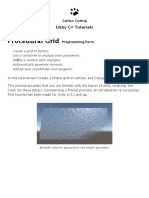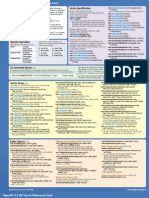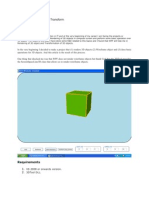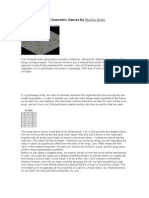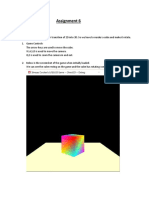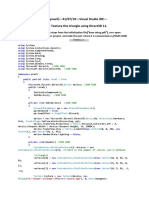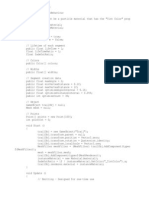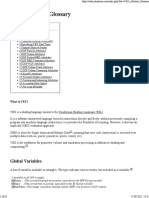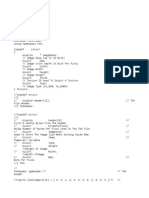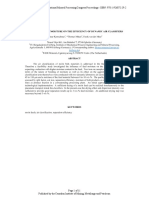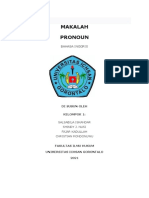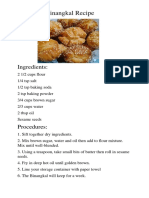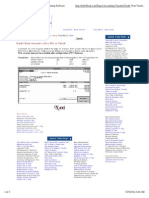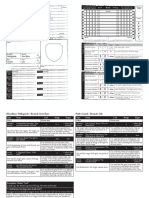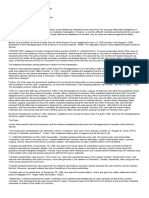Manual Scripting API Search scripting... unity.
com
Version: Unity 6.1 (6000.1) C#
Mesh
class in UnityEngine / Inherits from:Object/ Implemented in:UnityEngine.CoreModule Leave feedback
SWITCH TO MANUAL
Description
A class that allows you to create or modify meshes.
Meshes contain vertices and multiple triangle arrays.
Conceptually, all vertex data is stored in separate arrays of the same size. For example, if you have a mesh of 100 Vertices, and want to have a position, normal and two texture
coordinates for each vertex, then the mesh should have vertices, normals, uv and uv2 arrays, each being 100 in size. Data for i-th vertex is at index "i" in each array.
For every vertex there can be a vertex position, normal, tangent, color and up to 8 texture coordinates. Texture coordinates most often are 2D data (Vector2), but it is possible to
make them Vector3 or Vector4 if needed. This is most often used for holding arbitrary data in mesh vertices, for special effects used in shaders. For skinned meshes, the vertex
data can also contain boneWeights.
The mesh face data, i.e. the triangles it is made of, is simply three vertex indices for each triangle. For example, if the mesh has 10 triangles, then the triangles array should be 30
numbers, with each number indicating which vertex to use. The first three elements in the triangles array are the indices for the vertices that make up that triangle; the second three
elements make up another triangle and so on.
Note that while triangle meshes are the most common use case, Unity also supports other mesh topology types, for example Line or Point meshes. For line meshes, each line is
composed of two vertex indices and so on. See SetIndices and MeshTopology.
Simple vs Advanced Mesh API
The Mesh class has two sets of methods for assigning data to a Mesh from script. The "simple" set of methods provide a basis for setting the indices, triangle, normals, tangents,
etc. These methods include validation checks, for example to ensure that you are not passing in data that would include out-of-bounds indices. They represent the standard way to
assign Mesh data from script in Unity.
The "simple" methods are: SetColors, SetIndices, SetNormals, SetTangents, SetTriangles, SetUVs, SetVertices, SetBoneWeights.
There is also an "advanced" set of methods, which allow you to directly write to the mesh data with control over whether any checks or validation should be performed. These
methods are intended for advanced use cases which require maximum performance. They are faster, but allow you to skip the checks on the data you supply. If you use these
methods you must make sure that you are not supplying invalid data, because Unity will not check for you.
The "advanced" methods are: SetVertexBufferParams, SetVertexBufferData, SetIndexBufferParams, SetIndexBufferData, SetSubMesh, and you can use the MeshUpdateFlags to
control which checks or validation are performed or omitted. Use AcquireReadOnlyMeshData to take a read-only snapshot of Mesh data that you can use with C# Jobs and Burst,
and AllocateWritableMeshData with ApplyAndDisposeWritableMeshData to create Meshes from C# Jobs and Burst.
Manipulating meshes from a script
There are three common tasks that might want to use the Mesh API for:
1. Building a mesh from scratch: should always be done in the following order:
a) Assign vertices
b) Assign triangles.
using UnityEngine;
public class Example : MonoBehaviour
{
Vector3[] newVertices;
Vector2[] newUV;
int[] newTriangles;
void Start()
{
Mesh mesh = new Mesh();
GetComponent<MeshFilter>().mesh = mesh;
mesh.vertices = newVertices;
mesh.uv = newUV;
mesh.triangles = newTriangles;
}
}
2. Modifying vertex attributes every frame:
a) Get vertices
b) Modify them
c) Assign them back to the mesh.
using UnityEngine;
public class Example : MonoBehaviour
{
void Update()
{
Mesh mesh = GetComponent<MeshFilter>().mesh;
Vector3[] vertices = mesh.vertices;
Vector3[] normals = mesh.normals;
for (var i = 0; i < vertices.Length; i++)
{
vertices[i] += normals[i] * Mathf.Sin(Time.time);
}
mesh.vertices = vertices;
}
}
3. Continously changing the mesh triangles and vertices:
a) Call Clear to start fresh
b) Assign vertices and other attributes
c) Assign triangle indices.
It is important to call Clear before assigning new vertices or triangles. Unity always checks the supplied triangle indices whether they don't reference out of bounds vertices. Calling
Clear then assigning vertices then triangles makes sure you never have out of bounds data.
using UnityEngine;
public class ExampleClass : MonoBehaviour
{
Vector3[] newVertices;
Vector2[] newUV;
int[] newTriangles;
void Start()
{
Mesh mesh = GetComponent<MeshFilter>().mesh;
mesh.Clear();
// Do some calculations...
mesh.vertices = newVertices;
mesh.uv = newUV;
mesh.triangles = newTriangles;
}
}
Properties
Property Description
bindposeCount The number of bind poses in the Mesh.
bindposes The bind poses. The bind pose at each index refers to the bone with the same index.
blendShapeCount Returns BlendShape count on this mesh.
boneWeights The BoneWeight for each vertex in the Mesh, which represents 4 bones per vertex.
bounds The bounding volume of the Mesh.
colors Vertex colors of the Mesh.
colors32 Vertex colors of the Mesh.
indexBufferTarget The intended target usage of the Mesh GPU index buffer.
indexFormat Format of the mesh index buffer data.
isReadable Returns true if the Mesh is read/write enabled, or false if it is not.
normals The normals of the Mesh.
skinWeightBufferLayout The dimension of data in the bone weight buffer.
subMeshCount The number of sub-meshes inside the Mesh object.
tangents The tangents of the Mesh.
triangles An array containing all triangles in the Mesh.
uv The texture coordinates (UVs) in the first channel.
uv2 The texture coordinates (UVs) in the second channel.
uv3 The texture coordinates (UVs) in the third channel.
uv4 The texture coordinates (UVs) in the fourth channel.
uv5 The texture coordinates (UVs) in the fifth channel.
uv6 The texture coordinates (UVs) in the sixth channel.
uv7 The texture coordinates (UVs) in the seventh channel.
uv8 The texture coordinates (UVs) in the eighth channel.
vertexAttributeCount Returns the number of vertex attributes that the mesh has. (Read Only)
vertexBufferCount Gets the number of vertex buffers present in the Mesh. (Read Only)
vertexBufferTarget The intended target usage of the Mesh GPU vertex buffer.
vertexCount Returns the number of vertices in the Mesh (Read Only).
vertices Returns a copy of the vertex positions or assigns a new vertex positions array.
Constructors
Constructor Description
Mesh Creates an empty Mesh.
Public Methods
Method Description
AddBlendShapeFrame Adds a new blend shape frame.
Clear Clears all vertex data and all triangle indices.
ClearBlendShapes Clears all blend shapes from Mesh.
CombineMeshes Combines several Meshes into this Mesh.
GetAllBoneWeights Gets the bone weights for the Mesh.
GetBaseVertex Gets the base vertex index of the given sub-mesh.
GetBindposes Gets the bind poses of the Mesh.
GetBlendShapeBuffer Retrieves a GraphicsBuffer that provides direct read and write access to GPU blend shape vertex data.
GetBlendShapeBufferRange Get the location of blend shape vertex data for a given blend shape.
GetBlendShapeFrameCount Returns the frame count for a blend shape.
GetBlendShapeFrameVertices Retreives deltaVertices, deltaNormals and deltaTangents of a blend shape frame.
GetBlendShapeFrameWeight Returns the weight of a blend shape frame.
GetBlendShapeIndex Returns index of BlendShape by given name.
GetBlendShapeName Returns name of BlendShape by given index.
GetBonesPerVertex The number of non-zero bone weights for each vertex.
GetBoneWeightBuffer Retrieves a GraphicsBuffer that provides direct read and write access to GPU bone weight data.
GetBoneWeights Gets the bone weights for the Mesh.
GetColors Gets the vertex colors of the Mesh.
GetIndexBuffer Retrieves a GraphicsBuffer to the GPU index buffer.
GetIndexCount Gets the index count of the given sub-mesh.
GetIndexStart Gets the starting index location within the Mesh's index buffer, for the given sub-mesh.
GetIndices Fetches the index list for the specified sub-mesh.
GetNativeIndexBufferPtr Retrieves a native (underlying graphics API) pointer to the index buffer.
GetNativeVertexBufferPtr Retrieves a native (underlying graphics API) pointer to the vertex buffer.
GetNormals Gets the vertex normals of the Mesh.
GetSubMesh Get information about a sub-mesh of the Mesh.
GetTangents Gets the tangents of the Mesh.
GetTopology Gets the topology of a sub-mesh.
GetTriangles Fetches the triangle list for the specified sub-mesh on this object.
GetUVDistributionMetric The UV distribution metric can be used to calculate the desired mipmap level based on the position of the camera.
GetUVs Gets the texture coordinates (UVs) stored in a given channel.
GetVertexAttribute Returns information about a vertex attribute based on its index.
GetVertexAttributeDimension Get dimension of a specific vertex data attribute on this Mesh.
GetVertexAttributeFormat Get format of a specific vertex data attribute on this Mesh.
GetVertexAttributeOffset Get offset within a vertex buffer stream of a specific vertex data attribute on this Mesh.
GetVertexAttributes Get information about vertex attributes of a Mesh.
GetVertexAttributeStream Gets the vertex buffer stream index of a specific vertex data attribute on this Mesh.
GetVertexBuffer Retrieves a GraphicsBuffer that provides direct acces to the GPU vertex buffer.
GetVertexBufferStride Get vertex buffer stream stride in bytes.
GetVertices Gets the vertex positions of the Mesh.
HasVertexAttribute Checks if a specific vertex data attribute exists on this Mesh.
MarkDynamic Optimize mesh for frequent updates.
MarkModified Notify Renderer components of mesh geometry change.
Optimize Optimizes the Mesh data to improve rendering performance.
OptimizeIndexBuffers Optimizes the geometry of the Mesh to improve rendering performance.
OptimizeReorderVertexBuffer Optimizes the vertices of the Mesh to improve rendering performance.
RecalculateBounds Recalculate the bounding volume of the Mesh and all of its sub-meshes with the vertex data.
RecalculateNormals Recalculates the normals of the Mesh from the triangles and vertices.
RecalculateTangents Recalculates the tangents of the Mesh from the normals and texture coordinates.
RecalculateUVDistributionMetric Recalculates the UV distribution metric of the Mesh from the vertices and uv coordinates.
RecalculateUVDistributionMetrics Recalculates the UV distribution metrics of the Mesh from the vertices and uv coordinates.
SetBindposes Sets the bind poses of the Mesh.
SetBoneWeights Sets the bone weights for the Mesh.
SetColors Set the per-vertex colors of the Mesh.
SetIndexBufferData Sets the data of the index buffer of the Mesh.
SetIndexBufferParams Sets the index buffer size and format.
SetIndices Sets the index buffer for the sub-mesh.
SetNormals Set the normals of the Mesh.
SetSubMesh Sets the information about a sub-mesh of the Mesh.
SetSubMeshes Sets information defining all sub-meshes in this Mesh, replacing any existing sub-meshes.
SetTangents Set the tangents of the Mesh.
SetTriangles Sets the triangle list for the sub-mesh.
SetUVs Sets the texture coordinates (UVs) stored in a given channel.
SetVertexBufferData Sets the data of the vertex buffer of the Mesh.
SetVertexBufferParams Sets the vertex buffer size and layout.
SetVertices Assigns a new vertex positions array.
UploadMeshData Upload previously done Mesh modifications to the graphics API.
Static Methods
Method Description
AcquireReadOnlyMeshData Gets a snapshot of Mesh data for read-only access.
AllocateWritableMeshData Allocates data structures for Mesh creation using C# Jobs.
ApplyAndDisposeWritableMeshData Applies data defined in MeshData structs to Mesh objects.
Inherited Members
Properties
Property Description
hideFlags Should the object be hidden, saved with the Scene or modifiable by the user?
name The name of the object.
Public Methods
Method Description
GetInstanceID Gets the instance ID of the object.
ToString Returns the name of the object.
Static Methods
Method Description
Destroy Removes a GameObject, component or asset.
DestroyImmediate Destroys the object obj immediately. You are strongly recommended to use Destroy instead.
DontDestroyOnLoad Do not destroy the target Object when loading a new Scene.
FindAnyObjectByType Retrieves any active loaded object of Type type.
FindFirstObjectByType Retrieves the first active loaded object of Type type.
FindObjectsByType Retrieves a list of all loaded objects of Type type.
Instantiate Clones the object original and returns the clone.
InstantiateAsync Captures a snapshot of the original object (that must be related to some GameObject) and returns the AsyncInstantiateOperation.
Operators
Operator Description
bool Does the object exist?
operator != Compares if two objects refer to a different object.
operator == Compares two object references to see if they refer to the same object.
Did you find this page useful? Please give it a rating:
Report a problem on this page
Is something described here not working as you expect it to? It might be a Known Issue. Please check with the Issue Tracker at issuetracker.unity3d.com .
Copyright ©2005-2025 Unity Technologies. All rights reserved. Built from: 6000.1.15f1 (090817289254). Built on: 2025-07-28.
Tutorials Community Answers Knowledge Base Forums Asset Store Terms of use Legal Privacy Policy Cookies Do Not Sell or Share My Personal
Information Your Privacy Choices (Cookie Settings)



